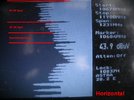The first null of 2f passes just east of Hamburg. Rostock is already in the sidelobe.
The beam shaping on 2E/2F uses antenna surface shaping to manipulate the footprint shape. Comparing the contours of the null points derived from the model of a simpler, non-shaped, 2.6m dish with the null points on the actual 2F UK spot footprint, the effect of the shaping produces a tighter beam. The contour for the first null actually crosses the NE coast of Spain well south of Barcelona - the reported null point. Similarly, the same contour crosses the N German coast almost on the Polish border, whereas, as cazhh reported, Rostock is actually in the sidelobe and the first null is between Hamburg and Rostock, further to the west.
The above is not surprising given that one reason for the beam shaping is a tighter beam. With a non-shaped dish you need a larger dish for a more sharply focused beam. The 2F UK shaped dish has resulted in a 1st null line equivalent to a larger, 3m diameter, non-shaped dish (at least for that 1st null line south and east of the UK).
The shaped dish can perhaps be thought of as a number of mini-dishes within the surface of the dish. It appears that, for regions south of the main lobe, the net effect is that of a plain dish whose curvature corresponds to a 3m diameter. This is, of course, pure speculation. However, a 3m plain, parobolic dish has the 1st null running straight through Barcelona, the second null passes just south of Gibraltar and the Costa del Sol and, at the midpoint of those two contours, the peak on the sidelobe passes through Valencia. Also, on the German coast, the first null is correct - between Hamburg and Rostock.
This reasoning would be more compelling if the Canaries, where 2F reception is possible, were sitting on the 2nd peak of the 3m dish. Sadly not so! To place the Canaries on that peak you have to assume a 2.6m dish. Is it possible that well away from the the main, central lobe, as in the case of the Canaries, the shaped dish behaves more like a plain paraboloid? However, you can't have it both ways. For me, that's one speculation too far. An alternative explanation for the Canaries is that, for some reason, the UK spot beam shaping has produced a Canaries hot spot, as is the case on the pan-European beam. But why would they do that?
It seems the only sane conclusion is that, if you want to model the whole footprint of a shaped dish, use the software used by the designers - but you may be able to model individual null contours using software intended for smooth, parabolic reflectors and playing with the dish diameter setting.
It is possible to obtain limited and student editions of modelling software for beam shaping. Examples: Grasp9, Cobr, Satsoft
See Section 15 of:
http://cdn.intechopen.com/pdfs/9287/InTech-Modern_communication_satellite_antenna_technology.pdf

